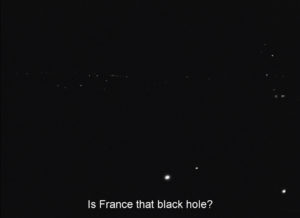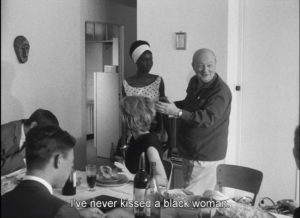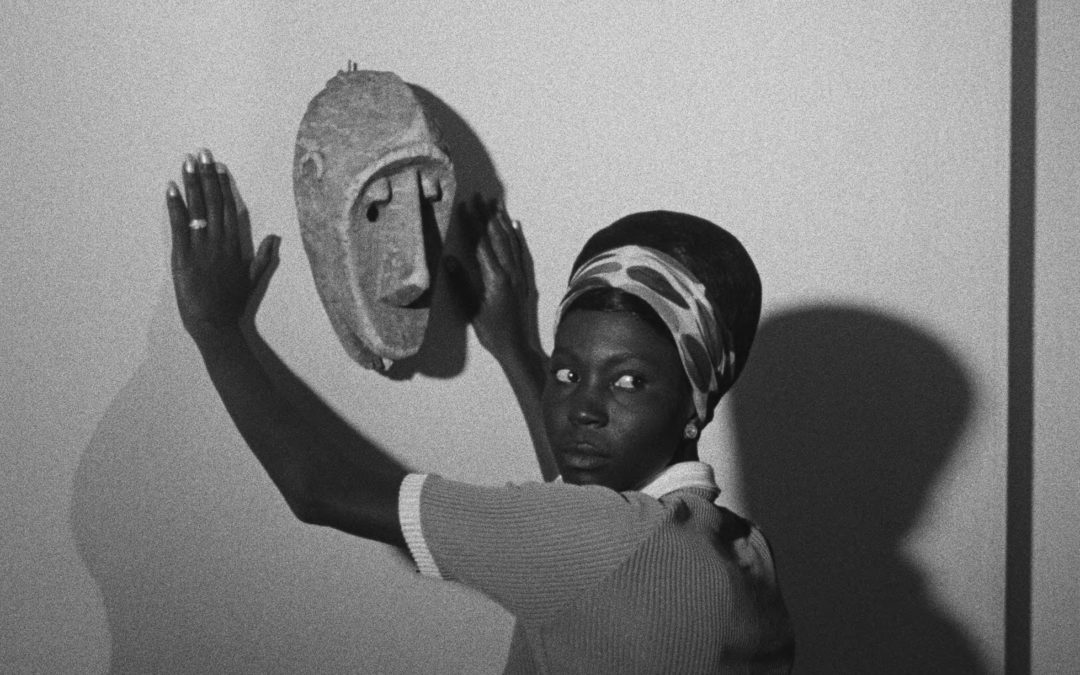One of my favorite films used to be The Help (2011), directed by Tate Taylor, but now I know that this film is considered a ‘white-savior’ film, and that’s changed my mind completely. A ‘white-savior’ in film is when a white person “saves” people of color – like in The Help, Skeeter (Emma Stone) helps Aibileen (Viola Davis) and Minny (Octavia Spencer) feel free from their jobs after writing a book about them. Ousmane Sembene directed Black Girl in 1966, which focuses on the same topic of Black domestic work, but more does it more appropriately and without an emphasis on the white-savior archetype. In this short 58-minute film we follow a Senegalese girl named Diouana (M’Bissine Thérèse Diop) who works for a French couple living in Dakar. However, the wife of the house —addressed as Madame in the story (Anne-Marie Jelinek)— who hired her starts to become more demanding and controlling throughout the film, forcing Diouana into a state of misery.
Black Girl was adapted into Sembene’s first feature film from his own short story, as he was a writer before becoming a filmmaker. This film was ground-breaking in more than just it’s message since it was also recognized as the first film to be shot in Africa and directed by an African man. Even today, white, cis-gender male directors dominate the playing field. Still, Black directors such as Spike Lee don’t hesitate to use their films to communicate racial issues in a way that’s more direct and sometimes easier for audiences to understand. I have only seen one of Lee’s movies –Do the Right Thing (1989)– but I will be learning much more about his filmography, who he is as a director, and about other Black directors as well in the future. Especially with our society’s current atmosphere, we are faced with a choice about how and if we educate ourselves on racial topics. I have chosen—and want—to become more educated. Being a minority myself as a Korean American, I know how important it is to stand up for those who do not have a large platform, or are too fearful, to stand up for themselves. I am still learning every day, and Sembene’s film is a great avenue to begin or further develop your research and understanding of racial conflict and history; despite being from the 1960’s, the message portrayed on race is still devastatingly relevant.
Similar to Shoot the Piano Player, this film is narrated with inner dialogue from Diouana, although she doesn’t say an actual word out loud until towards the end. The couple talks to Diouana throughout the film but she doesn’t respond, apart from when she says “Oui, Madame” (Black Girl). Sembene does a great job of cementing the film’s focus on Diouana’s feelings and point of view. This detail brings me to question the way many Hollywood films tend to misrepresent race—sometimes using actors who aren’t actually the race or ethnicity they are portraying—and are usually directed by a white director. Ousmane differs from this as he is Senegalese himself and grew up in Ziguinchor, a city in the area of Casamance in Senegal. He has also recognized that women played a prominent role in his youth and he looked up to many of them, one of whom being his grandmother, and this has played into some of his work. Thus, Black Girl speaks on the issues of race with underlying tones and hints of feminism.
We’re placed into the film’s timeline at a point where Diouana has been working for the couple for a while. It’s not made clear in the film if their primary home is in Dakar or France, but the narrative seems to lean towards their primary home being in Dakar and they travel to another residence in France. Nonetheless, Madame invited Diouana to come with them. When she gets to France, she becomes a housemaid. Previously, she’d been a nursery maid, which was her primary role back in Dakar. Confused about the sudden change of positions, she feels trapped and enslaved. Most of the film takes place inside the couple’s small French apartment, re-emphasizing this ‘trapped’ feeling. Diouana talks about how she feels like a prisoner because she thought she would be able see the city and the beaches; instead, she continuously gets put to work, day in and day out. We feel the same way as viewers seeing this, even though we are not Diouana; We see the glittering city lights from the same window she looks out of, but we never get to go and see the beautiful city up-close either. If you have read any of my prior essays, you know how much I enjoy France’s fantastic scenery, so I really felt for Diouana and could understand her longing.

The view from Diouana’s window.
The film sprinkles in some racist conversations between the French couple and the couple’s friends. They don’t even try to hide their remarks and comments, as if their conversation is an everyday dinner table-talk, even while Diouana is present. At one point, one of the friends asks if Diouana can speak French, and Madame replies that she understands it but can’t speak it, and her friend openly says, “Like an animal” (Black Girl). In 1966 the civil rights movement was still going on in America, so this type of conversation and behavior was still occurring, even though change was in the works. My mouth dropped open at some of the things they would say about Diouana, and to her, so casually. There is another scene where Diouana brings them a mask from her hometown as a gift, and the husband analyzes it and says, “Looks like the real thing”, as if her hometown and ethnicity weren’t real or valid before. Eventually, Madame becomes so controlling and demanding that even her husband drinks the days away to get away from her bickering.

One of Madame’s friends asking to kiss Diouana (M’Bissine Thérèse Diop).

Madame (Anne-Marie Jelinek) checking in afterwards and telling her it was a joke.
By the end of the film, Diouana gets so fed up with Madame, her working conditions, and her own feelings of entrapment that she takes back her mask and takes her own life, committing suicide. The husband brings the mask and Diouana’s suitcase to Diouana’s mother and also tries to give her the money Diouana earned, but she is not interested. There isn’t any gore besides some blood shown in the suicide scene and we don’t see the couple’s reaction to finding her body either. It’s simple but gets the point across. Like many other French New Wave films, dying and death isn’t overly dramatic, and most times, we don’t even see it happen; we just see the aftermath. The point is that the focus should be more on what the person represented and stood for rather than their presence being gone, although it is a factor into grief and emotion in each film. The French New Wave was the perfect era for this film to debut because the movement was all about self-expression and was constantly working to tear down boundaries. The idea might have been radical in 1966, but it was simultaneously inspirational to many.


Recent Comments